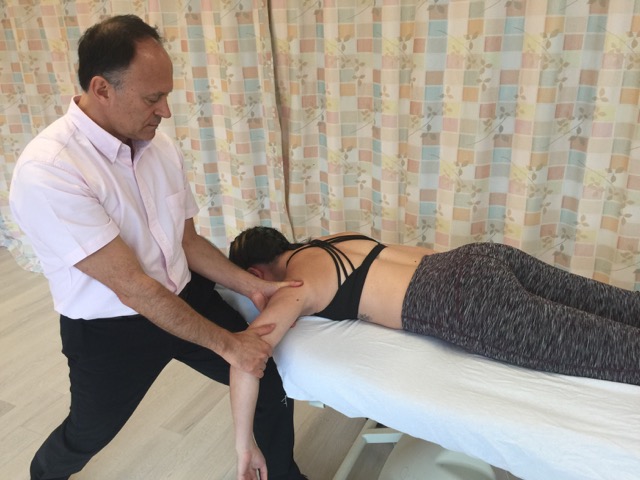Manual therapy treatment of frozen shoulder:
Frozen shoulder often responds extremely well to manual therapy treatment. Depending on how long it has been present, it might require many months of treatment, but it often fully or nearly fully resolves with regular care; the emphasis is on consistent and regular care. Most every neuromuscular condition responds well to the mainstays of clinical orthopedic treatment; they are moist heat (or ice), soft tissue manipulation (massage), stretching, and joint mobilization. With frozen shoulder, moist heat and soft tissue manipulation are important, but should be performed with the aim of increasing the efficiency of the stretching and joint mobilization, which are the two essential treatment modalities.
Begin by spending approximately 10 minutes warming up the entire upper quadrant from the mid thoracic region down to the forearm; gradually increase the pressure from light to medium intensity. Now return to the shoulder region with a more intense exploration of the muscles of the GH joint, working with medium to deep pressure into any global tightness, myofascial trigger points, and fascial adhesions found; depending on what is found, spend anywhere from approximately 10-20 minutes. Place moist heat on the anterior and/or posterior sides of the GH joint for five minutes and then begin stretching the region.
Stretching should be focused on each ROM that is restricted. The pace of stretching should be slow and deliberate, but firm and assertive. Each repetition should gently but firmly challenge the client’s shoulder to increase its ROM, but it is important to not be heavy handed or impatient and force the stretch beyond a degree or two of motion with each repetition. Always let the patient’s/client’s response to your care be your guide. To focus the stretch to the capsule and capsular ligaments of the GH joint, it is extremely important to stabilize the scapula to prevent it from moving when stretching the arm at the GH joint.
To the degree that the neurogenic phase is present, utilization of a neural inhibition technique such as contract relax (CR, also known as PIR or PNF), agonist contract (AC), or CRAC (contract relax agonist contract) is beneficial and should be used. Theoretically, if the client’s condition is purely adhesive capsulitis, then muscle tone is the not issue and spending the extra time for a neural inhibition stretch would not be efficient. However, even in later stages of frozen shoulder, there is usually some component of neurogenic contraction present, so always try neural inhibition stretching to see if it is more effective than simple mechanical stretching. Given how stubborn frozen shoulder can be, it is important to perform two sets for each ROM that is being treated.
Now perform Grade IV joint mobilization (arthrofascial stretching; AFS) of the GH joint. Mobilize the head of the humerus in all directions (anterior, posterior, inferior, and superior glides, as well as spin mobilization in both directions and axial distraction/traction). If abduction is restricted, focus on inferior glide; if lateral rotation is restricted, focus on anterior glide. If flexion is restricted, focus on inferior glide and spin mobilization. Whenever possible, it is always helpful to add an element of traction to all joint mobilization directional glides.
If time remains, repeat the stretching protocol to the restricted GH joint ranges of motion. If further time remains, work the patient’s/client’s other upper extremity to prevent possible problems there due to the increased compensatory use/reliance on it because of the frozen shoulder. Note: Icing only needs to be done if the depth of work is very strong and the icing is necessary to either minimize swelling and/or client/patient pain/discomfort.
Summary of Manual Treatment Protocol for Frozen Shoulder
| 1. Warm up the upper quadrant with light to medium pressure |
| 2. Deep work to the muscles of the GH joint |
| 3. Moist heat |
| 4. Stretching |
| 5. Grade IV joint mobilization (arthrofascial stretching) |
| 6. Repeat stretching |
| 7. Ice if appropriate |
| 8. Work other upper extremity if time allows |
Precautions/contraindications when treating frozen shoulder:
There are no specific precautions or contraindications when working on a client/patient with frozen shoulder other than being careful to not be overly forceful when stretching the tissues. Stretching should be firm and assertive, but not aggressive.



